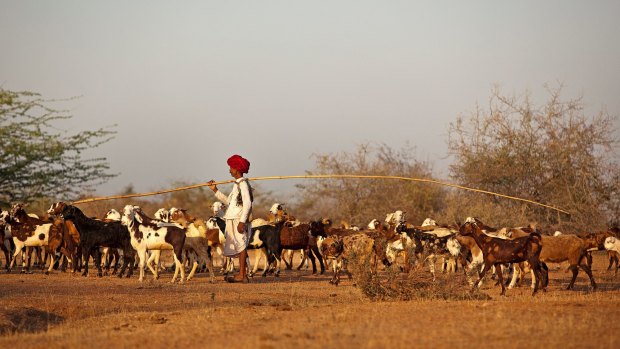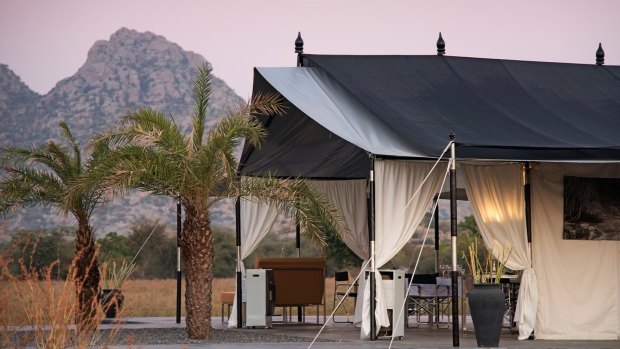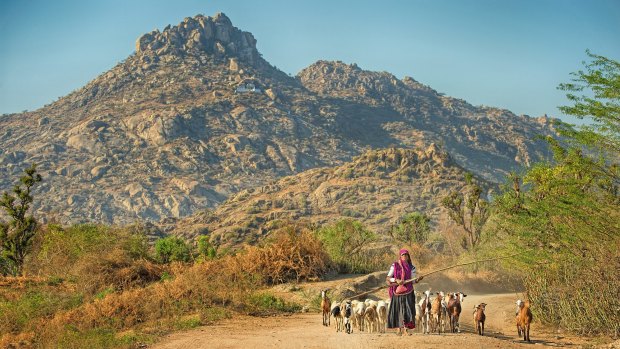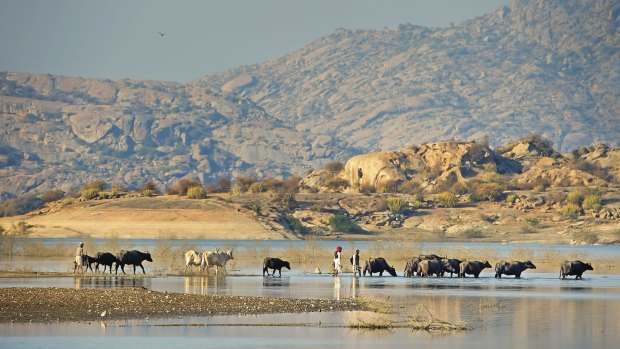This was published 5 years ago
Rajasthan safari to Sujan Jawai wilderness camp: Home to a dying way of life
A remote corner of India reveals a way of life in greater danger than the magnificent animals around it.

A Rabari shepherd tends his goats.
I could never have imagined that one of the world's most elegant and rarest creatures could possibly be upstaged by a mere human, let alone by a slightly, well, less glamorous beast.
But, sure enough, up ahead, here in the remote south-west of Rajasthan, there is the bucolic spectacle of a weathered and wizened elderly shepherd, bedecked in a elaborately-tied scarlet-coloured turban and dressed in an all-white waistcoat and dhoti, a type of pants.
He emerges from a cloud of dust ahead of our safari Jeep, marshalling a herd of bleating goats, to which he is singing.

Tented luxury at Sujan Jawai wilderness camp.
The shepherd's crooning stops only as he pauses to greet our driver and guide with a grey-moustachioed grin as wide as a masala dosa. Then he and his goats are off again, plunging back into the dust.
In three decades or so, although the Indian leopards that inhabit this part of India may well still be prowling the rocks around these parts, this timeless scene of shepherd and goats, unchanged for centuries, could be no more.
The shepherd, you see, is nearly as vulnerable as the leopard itself, which nowadays total as few as 14,000 across the nation compared with about 4000 tigers. He is a member of the mysterious and marginalised Rabari (meaning "outsiders") peoples, regarded as one of the three dozen or so most endangered tribal groups on the planet.

A Rabari shepherd provides a splash of colour in Jawai's semi-arid scrubland.
The semi-nomadic Rabari, who are believed to have originated in Iran centuries ago, are, along with leopards, a key point of interest at Sujan Jawai, a five-star luxury wilderness camp a three hour or so drive from Jodhpur and which I'm fortunate to be visiting for a few days.
Jawai, part of the wider Pali district, consists of semi-arid scrubland studded with gigantic, near monolithic dome-shaped granite hills, or kopje, a word borrowed from the Afrikaans. They are a little like a multitude of Ulurus in miniature and they provide the perfect habitat for leopards, who reside in caves between the boulders, and provide visual relief on a stark and colourless landscapes.
So large and smooth are these stony hills, with some loftier ones near pyramid shaped, that it's possible to drive a Jeep right up and across them, making for perfect access to the best spots to observe leopards. The other dominant physical feature of Jawai is the eponymous dam, built by a maharaja just after World War II, which provides the water supply to Jodhpur and the surrounding districts.

Shepherds in Jawai.
A model of small-scale conservation tourism, the stylish Sujan Jawai was conceived by a wealthy Indian couple, Anjali and Jaisal Singh, who made their fortune in the decidedly more prosaic automotive components industry. Much of the revenue from the camp has been redirected into local community projects dedicated to education and sanitation.
There are just nine luxury tents, including a lavish royal suite (or as lavish as any tent can get), ensuring an intimate experience with the commensurate price-tag. As we settle into the accommodation I'm pleased to learn of the most curious aspect of Jawai, the co-existence that exists between man and beast in these parts.
Not a single villager in this area has been killed by a leopard for nearly 170 years. Rabari respect the leopards to such an extent that on the occasions they attack and kill one of their goats during the night they seek no vengeance or retribution for the kill. They view such incidents pragmatically, akin to an offering, especially as they recognise the benefits that leopards have brought their lives.
Even in spite of the absence of leopard attacks on humans, it's comforting to know that tall, imposing, middle-aged Rabari men serve as security personnel at the camp, and, while they can at times feel like props, the income derived appears to be appreciated judging by the warm welcome that travellers receive from villagers.
It is April when we visit, just before the onset of the searing Rajasthan summer when temperatures routinely reach 50 degrees and above and the dam dries up. Fortunately, our luxury canvas tent, designed in a kind of 1930s-style semi-industrial chic featuring tubular chrome with black notes, is fully air-conditioned (which seems a little like cheating but we give thanks to Shiva for it).
There is also hot and cold running water in a hotel-standard ensuite bathroom, reached by a zippered canvas flap "door".
Outside on a veranda there is even a romantic metal writing desk, Out of Africa-style, that looks out towards fields of tall straw-coloured grass (perfect conditions for a wandering leopard, harmless or not, so zip up at night). The monochromatic palette is relieved throughout the camp by splashes of red, a nod to the colour of the Rabari turbans.
One morning, with the hazy skies a strange lemony colour from the dust blown in from the deserts of Rajasthan, we head off into the bush on a leopard safari. After about a hour of searching we spot a female that has emerged from her cave. She is basking in the warmth of the early morning sun on the exposed side of a sizeable granite hill.
Her satisfied, supine appearance may be due to the fact that she is believed to have attacked and eaten a village dog earlier that morning, sharing it with her cubs. Now, our guide tells us, is her "alone time" away from her demanding offspring.
After some grooming, interrupted by impressive yawns, the leopard disappears back to her cave lair only to soon re-emerge with one, then two and, finally, three of her cubs. It's all starting to feel rather like a Sir David Attenborough documentary crossed with Picnic a Hanging Rock.
The leopards are gorgeously camouflaged among the rocks and hard to discern with the naked eye, making binoculars essential for viewing from the Jeep. As we observe these magnificent creatures the silence that envelopes us in this empty corner of India makes us wonder where all of those 1.3 billion and more souls of the world's most populous country have gone.
Here in Jawai, in a 60-kilometres-square zone, there are 14 Indian leopards, which to the uninitiated doesn't sound many but which, in reality, our guide assures us, represents over-population. Remarkably, a single leopard typically requires a territory of 20 square kilometres in which to roam and sooner rather than later a decision will be made as to how best manage the local leopards.
But, as sublime as the leopards are, we find ourselves irrevocably drawn back to the Rabari, intrigued by the sight of the distant white Hindu temples dotted across the landscape that we can see from the atop the granite hills while scouting leopards.
Our guide escorts us to a hilltop temple to witness a traditional morning aarti religious ceremony, which is designed to awaken the gods with the use of loud drums, bells, gongs, fire and even garish flashing neon lights. It goes some way to illustrating the plight faced by the imperilled Rabari. Every one of those involved is elderly, including the priest, with young members of the tribe abandoning the ancient way of life, including traditional dress and goat herding, for a better life in the big towns and cities.
The temple's elderly and frail priest is apparently in his 60s (few people knows their exact ages in Jawai) but he looks 20 years older. He wearily conducts the intense and clamorous ceremony – noisy enough to wake a distant snoozing leopard – and I wonder who will replace him when he can no longer perform this elaborate ritual.
On our last day, after spending the middle of each day relaxing and sheltering from the intense heat, we conclude our final leopard safari by being transported in the late afternoon to a granite hillside overlooking the silvery receding waters of Jawai Dam as the unforgiving summer months resolutely advance.
A well-drilled crew from the Sujan Jawai camp has arrived ahead of us and decorated the hillside with scattered tea-lights that flicker in the fading light. A traditional woven Rabari rug for a touch of comfort and protection from the heat emanating from the rocky hillside has been spread out for us.
Snacks and drinks are served and we're invited to relax on the rocks, a little like that mother leopard, and savour the exquisite wilderness a final time. The only sounds are the occasional squawk, not from a bird but from the two-way radio in our Jeep, parked up the hill from us, as the last glimpse of the dusky Rajasthan sun disappears behind the craggy outline of a towering heavily-bouldered hillside across the reservoir waters.
The horn from a trundling train, on its way from Mumbai to Jaipur, echoes from a few kilometres or more away and we what we need now to complete this idyllic scene in this surprising corner of Rajasthan before darkness envelopes Jawai is for a leopard to reveal itself, at a safe enough distance, or perhaps a crooning Rabari shepherd and his goats to suddenly appear from over the rocky hill.
FIVE MORE THINGS TO DO AND SEE
EXPLORE JAWAI BY BIKE
Jawai's generally flat landscape, along with its network of unsealed roads linking local villages, makes for perfect cycling conditions.
VISIT KUMBHALGARH FORT
An hour-and-half or so drive from Sujan Jawai, this 15th century fort is a UNESCO World Heritage site. Visit also the intricately-carved temples of the architecturally-splendid Ranakpur complex.
GO BIRDWATCHING
Jawai Dam is home to 170 species of birdlife, with the dam providing the perfect habitat for spectacular migratory varieties in the winter months, such as flamingos.
DINE IN STYLE AND SECLUSION
At Sujan Jawai guests can dine by day and by night at secluded corners of the camp as well as outside with food prepared from produce from the camp's own kitchen gardens and local farms.
VISIT THE MOTORCYCLE TEMPLE
Travelling to or from Jawai to Jodhpur, break your journey at the temple where a motorbike, namely a glass-encased Royal Enfield (India's adopted national motorcycle) is worshipped.
TRIP NOTES
STAY
Sujan Jawai can be booked as part of a tailored package holiday to Rajasthan with the Sydney-based Classic Safari Company. Rates for Sujan Jawai start $684 per person, twin share, per night and include luxury tented accommodation, all meals and two daily game drives. See www.classicsafaricompany.com.au
FLY
Singapore Airlines operates more than 130 flights per week from six Australian cities, including Sydney and Melbourne, to Singapore, with twice daily connections to Delhi. Phone 13 10 11, visit your local travel agent or see www.singaporeair.com
MORE
Anthony Dennis travelled to India as a guest of the Classic Safari Company and Singapore Airlines
Sign up for the Traveller Deals newsletter
Get exclusive travel deals delivered straight to your inbox. Sign up now.